In the last episode I left you hanging – I was on the run with KK pursued by her ex-boyfriend, with a loaded shotgun. He had reason – half his family was running away to England. We – KK, her three year old son Arrow and I – had sought refuge with the neighbour, a Black Panther from Chicago hiding out.
Late that night I went with the Panther to the nearest town for cigs. Rushing back to his car, I found myself abandoned with a pack of cigarettes in the falling snow in front of a now closed supermarket. The car had vanished, and survival time exposed to that weather was supposed to be four minutes. I was set to keel over when finally the gas-guzzler rattled into sight.
Inside the car I gave him the menthols I’d bought. He lit one for me. Had I been a pukka superhero, I would have asked what made him come back, but he was concentrating on driving – skidding all over the icy road – all he had to do was toss me out into the freezing snow.
Reaching the Panther’s place, he asked me why I read “kid stuff”. I showed him an episode from Little Orphan Annie – the eleven-year old with a moral sensibility in a Dickensian mode – and my all-time favourite. The Panther seemed to take me seriously after that.
Annie’s Junior Commandos was a breakthrough for equality. There was still segregation in the army. Later, the race issue was unceremoniously dropped, and Annie returned to the hidebound WASP domain, but these two rows say it all:
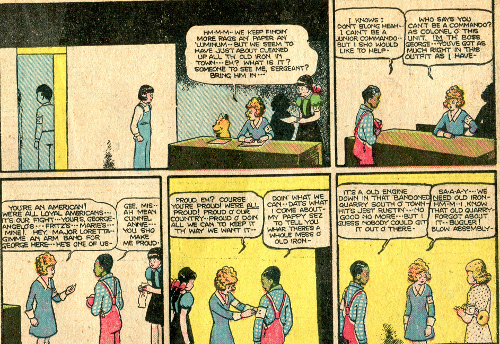
We slept on the floor that night in front of the wood burning range, fully dressed and wrapped in blankets. The intention was an early start.
In the morning we chugged up the snow-covered track out of the valley. Ahead of us the ex-boyfriend, drinking from a bottle of vodka. It was barely past sunrise. He emptied the shotgun in the air… and then collapsed in tears. It was pitiful, but we didn’t stop. We spluttered past him, heading for Spokane to take a flight to New York. Once there, we could stay a night with my sister and her disapproving psychiatrist husband in Long Island.
My shrink pal from the Upper West Side came to the rescue. His wife was amenable and so was their floppy dog, Brandy. It was not spacious in their Riverside Drive apartment, but the atmosphere was warm and cheerful.
It had been a few days, and I had to replenish my supplies. Luckily, there were ample vintage comic shops in Manhattan in those days. In that respect, London was still in its infancy. There were only two comic shops in London in the 70s: Dark they were and Golden Eyed in Covent Garden, and Forbidden Planet on the fringe of Soho, now an international success with a flagship store near the British Museum.
The Ethiopian-American curator of a Salvador Dali exhibition in Manhattan wanted me to meet John Henrick Clark. On a cold wide empty street in Harlem, we were welcomed by a rotund, chirpy man. We settled into his study – a scholar’s cave lined with books from floor to ceiling. I felt at home. I thought I saw a comic in amidst the clutter on his desk. I found Clark ebullient and indefatigable. During the McCarthy era he was a janitor at Hunter College. Years later he returned as its principal. He reminded me of Buckminster Fuller, who I had seen lecture in Cape Town as a young man. It crossed my mind that where ‘Bucky’ was lauded in Cape Town, in those days Clark would not have even been allowed into the country.
After our meeting, outside Clark’s brownstone, my friend looked at me and asked why I had not mentioned comic books? Had I known what he alluded to I would have kicked myself. After the 1960s had brought political and cultural change, one of the finest histories on race got underway in a comic book series: Golden Legacy. I had no idea of any connection to Clark until much later.
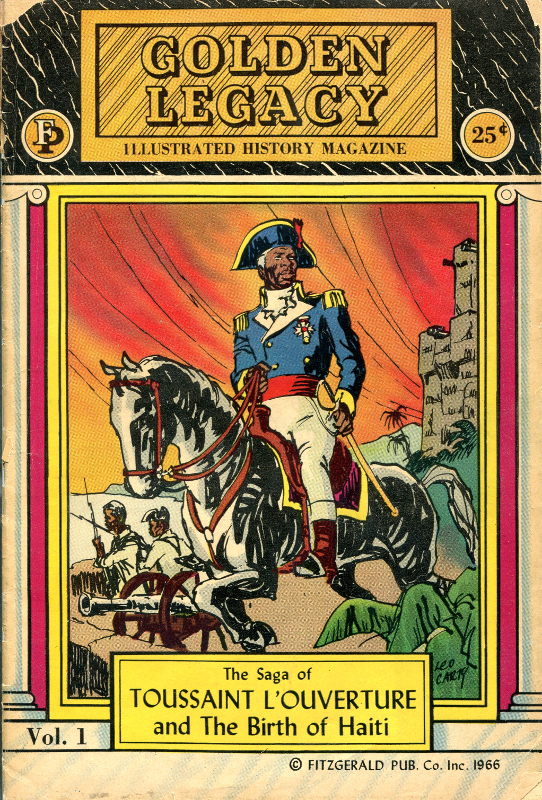
Clark, one of the foremost educationalists of the era, had written the introduction to Golden Legacy series:
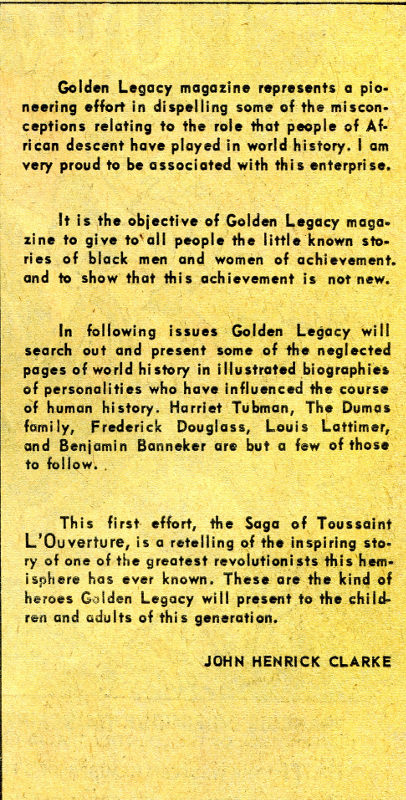
The three of us bundled up and made our way across Central Park to MOMA to see John Walsh the art historian. We’d previously met at a dinner. We’d talked comics. Giving us a tour of European paintings, he asked about Dickens in comics. I referred him to the Classics Illustrated reprints of Dickens novels, but I told him that I wasn’t sure that Dickens would have approved – I’d read that the great Victorian novelist resented Cruikshank’s illustrations for his serialised works. He felt that the pictures were noticed too much!
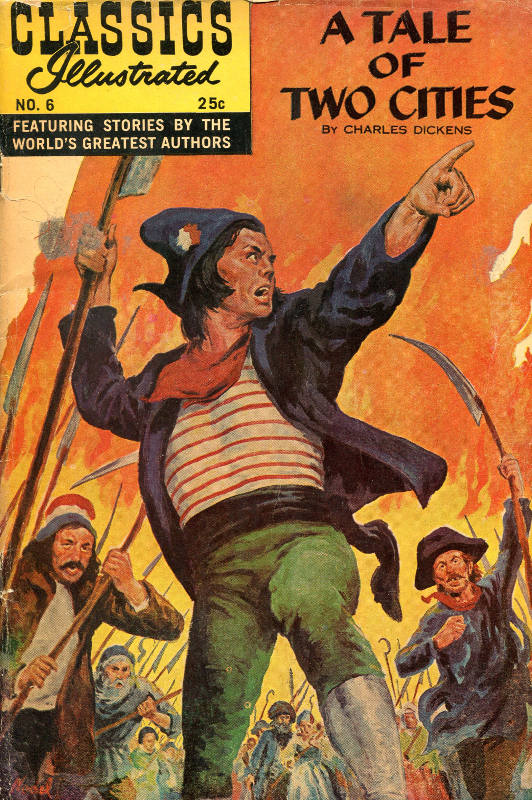
Dickens impacted across a broad spectrum down the years, but I always thought the same about the curly-haired redhead in Harold Gray’s saga of Annie, an orphan whose honesty, truth and sense of industry always won through; a conservative with rebellion in her soul – much like her creator.
David Copperfield was the subject of Classics Illustrated 48, an issue illustrated by H.C. Kiefer – a recognizable and distinctive sequential artist. Here, the grid layout was not sacrosanct, and neither was the shape of the frame. The scratchy line was appropriate for the social realism. Eight year old Copperfield, orphaned, robbed and homeless is similar to Annie’s predicaments.
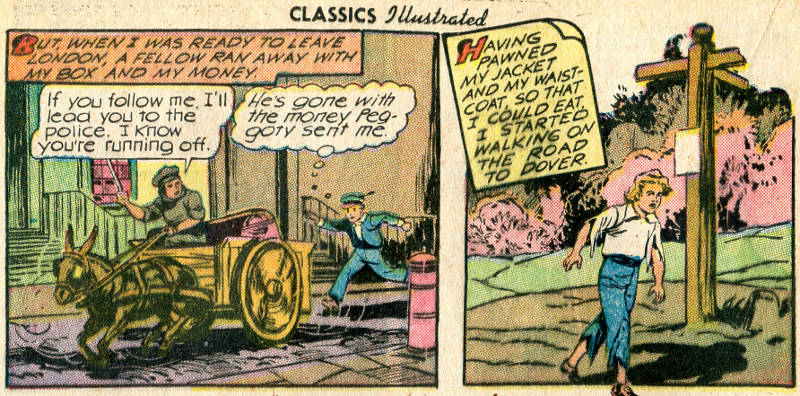
Though not much of a Dickensian, I could not be disparaging about the bearer of such a social conscience. Who else could have inspired scholar and author Harold Gray when he created the morally conscious, heartrending, feisty Annie? Look at these frames from 1930. The bobbing bottle is nerve-wracking: will it be noticed, or just float by? Warbucks getting the message is a superb and a thoughtful forerunner to Gray’s entry into magical realism. As ever with the trials and tribulations of the little tyke, the narrative never falters or flags. The stylised figures are framed with sequential precision. One is constantly swept along, enticed onwards.
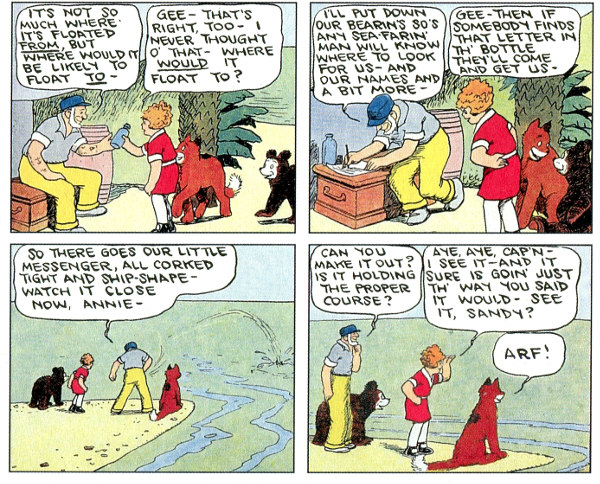
On board a passing ship a little boy tries to draw attention to the bobbing bottle, but isn’t believed…
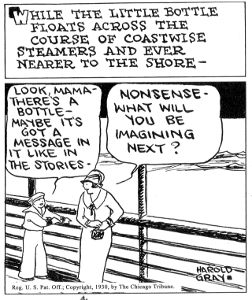
Finally the bottle is found – by an illiterate couple…
What Terry and the Pirates offered on the other hand, was romantic adventure. Noir feminism was in full flood there, and as dark and dirty as any that strode the celluloid frames. However, above and beyond the sheer romantic depth of Milton Caniff’s work, it reflected a common grammar linking cinema and comics. I’ve often thought that filmmakers would benefit from studying Terry and the Pirates, particularly for editing, camera point of view, structure and drama.
Here, Tony Sandhurst gets off to a foul start. The artwork says it all, down to the curl of his lip. Bad things must happen around a face like that.
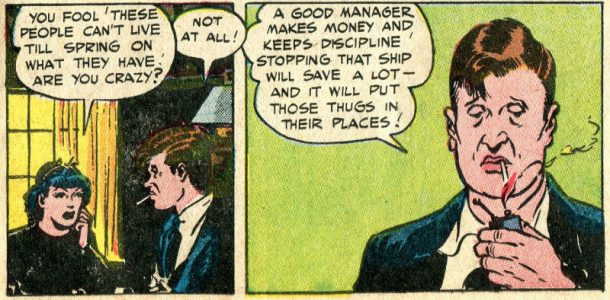
Terry’s Dragon Lady – the unfathomable femme fatale of the 1930s and 40s was equal to any leading lady in film noir, and she was Orson Wells’s favourite character. The rendering of sea vistas, landscapes, sunburst horizons, serve the drama, intrigue and high adventure flawlessly. Milton Caniff – the Rembrandt of comics!

My conversation with John Walsh took a literary turn. I left Annie with Dickens and focused on Trollope, providing a mutual depth of character portrayal with Terry and the Pirates. The American ideal – all are together, and going to rescue villainous Sandhurst, captured and tortured for starving Chinese villagers.
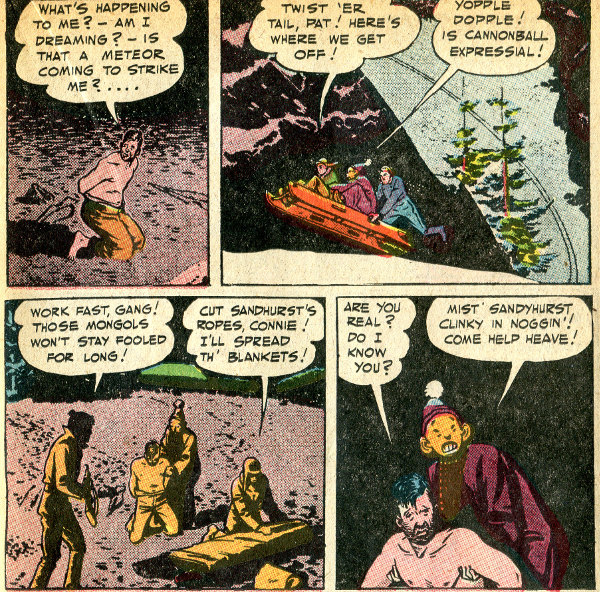
Tony Sandhurst is a manipulative sleaze who plummets to inconceivable calumny akin to Anthony Trollope’s Lopez in The Pallisers. Snobbery, race, class and entrapment engulf both Lopez and Sandhurst with equal venality here. I read recently in The New Yorker that Trollope was held in greater regard than Dickens.
Before I could continue with Sandhurst chicanery, JW interrupted. Weren’t the strips well before my time? True, but the most widely syndicated strips were serialised in comic books – which I collected. JW wanted to get me a job in the New York academic world. He told me I should live in America. I babbled on. My dream was to get my comics into the V&A, but I was suspicious of museums because of my childhood experience in the Natural History Museum in Cape Town.
Once, as a child I found myself lost amongst the huge Victorian cabinets filled with figures of Bushmen barely bigger than me. My surrogate Xhosa mother who looked after me, found me. Wiping away my tears, she swept me out. But nor before a guard warned her that only Thursdays were allocated for blacks. Next time they’d arrest her.
The experience stayed with me. I had thought the Bushmen figures were real. Their sad eyes convinced me. Years later, I learnt that early colonial hunters killed the San hunter-gatherer people by hammering sharpened sticks up the anus just so the skin would be perfectly preserved for display.
Incorporated into The Phantom strips in the mid 1930s, the Bandar pygmies fared better perhaps, though other African figures got the usual stereotype treatment – ‘honouree’ whites, ‘good’ Indians etc. – a kind of papal dispensation sometimes attributed to quislings or to trusted slaves. The list goes on.

The Phantom lived in Bengali, a fictional mix of Africa and India. This strip had a tremendous international and enduring appeal. In Norway during the war, The Phantom was still appearing in the newspapers. Through those strips, the country knew that America had not been defeated. Their Nazi occupiers had lied. Initially, The Phantom had a matchless narrative with bold lines and uncluttered frames – statues in motion. Lee Falk was the writer, with different artists. Ray Moore set the tone with his unvarying strong, clean brushstrokes with unfussy background detail. Though masked and costumed and operating in much darkness there were few daytime shadows.
In 1810, Saartjie Baartman was displayed across Europe. Her people, the Khoisan, like the San, had steatopygia, and she was exhibited as ‘The Hottentot Venus’ in human zoos. Plied with an alcohol diet (used as a preservative, like formaldehyde), she died in 1815. Secretly and illegally, her corpse was dissected, and her genitals and vital organs were preserved and doctored in ghoulish fashion. Posthumously, her skeleton went to the Museum of Man in Paris, where it went back on exhibition and stayed there until 1974. She was finally buried in the Eastern Cape in 2002.
After much searching I found of course that the V&A displayed no such onerous artefacts! Consequently, I could aim to get my comics onto their shelves. I appreciated John Walsh’s flattering offer, but KK, Arrow and I agreed we should go home to Holland Park.
John Walsh said that nothing he offered could compete with the V&A. He warned me that I had a long struggle ahead of me. Little did I know. It was 25 years before I got the collection into the museum. When it finally happened in 1990, I contacted JW to say the collection had found its home. He wrote back, ‘like Terry flying through the flak.’
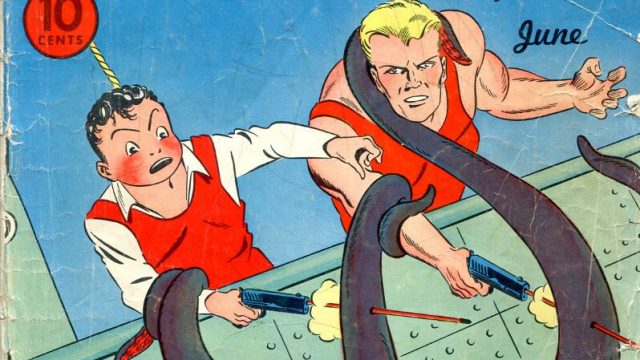
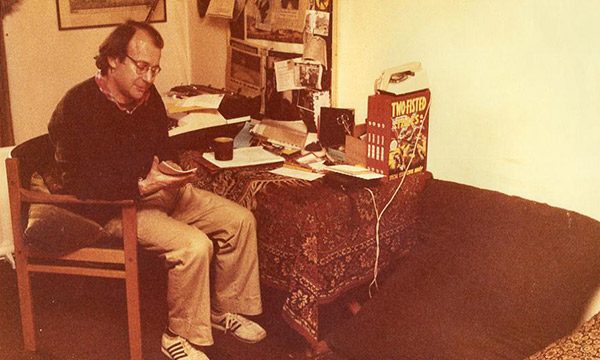
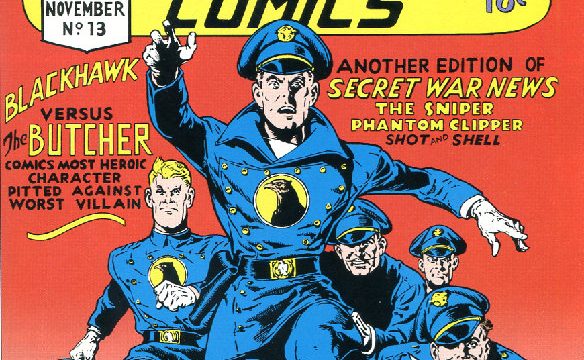
Very informative read, Ian. Pacy, pithy writing when dealing with personal tribulations. But erudite observations and analyses. Great stuff. x
I found this utterly fascinating, thanks for posting this latest ‘edition’. Although I know little of comics, I am thoroughly enjoying reading the hardships of life through the medium of your comic collection. You have led the most fascinating of lives. Rick
Another fascinating and well written indication of the links between race, comics and history that yua re exposing here, Ian — thank you.
Toby
The characters, art, cultural and political history, and the personal saga, are all blended by the passion of Ian. Thank you for the experience.
Very interesting and educational Ian. Some stories you’ve probably told me about before (and I’d forgotten) now made more graphic by your storytelling and visualisation in print. Like the name of the comic book shop “Dark they were and Golden Eyed”. Who came up with that? Mo
This is yet another highly enjoyable read. I also loved the images from the comics to enhance your storytelling. Please post your next adventures very soon.
I’m glad you mentioned Classics Illustrated – definitely a collection which as been overlooked! I think this is really important work Ian and I enjoy how you weave the personal with the political. Comics far from being ‘for kids’ expose issues words so often try to hide. Can you believe I actually read it at last!
Enjoyed this episode very much – it’s jam packed with personal adventure and in depth information. Being a bit of a museum enthusiast myself, I was particularly interested in your museum experiences and details. Glad the V&A accepted your collection in the end!
Another tremendous instalment. Segues from one century to another work brilliantly in the juxtaposition of comics with the classics; almost enough to make me want to read Trollope (is there a Classics Illustrated adaptation of Barchester?)…
In this day and age, you might want to put a ‘Trigger Warning’ at the top regarding your description of how the San hunter-gatherer people were killed. Any chance of increasing the size / resolution of Four Colour #18? It’s a little hard to read, but otherwise all great.
Mo – I believe it’s a quotation from The Martian Chronicles by Ray Bradbury – a description of when Earthmen meet the Martians for the first time, with the twist eventually being that they are…
Very enjoyable and what I would love to see is the B.D., or comic, version of your adventures. I learned about the great books through Classic Illustrated (to my mother’s horror, despite the fact that she was a leading publisher comics in the Middle East), and your Confessions Illustrated would be a great treat.
A brilliant adventure, expertly told Ian. Wow. You met John Henrik Clarke. Am jealous… Amazing. Catch up on more of your adventures soon…
The blog tells your story in a vivid and believable way cleverly weaving together your depth of knowledge about comics and your own life adventures in a narrative that sometimes blurs the lines between one and the other. How rewarding that your goal has been realised and that your collection now resides in the V & A.
Another great insight, thanks Ian. So rewarding to hear behind the scenes stories and how this collection came together. Can’t wait for the next installment.